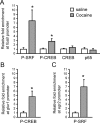Serum response factor and cAMP response element binding protein are both required for cocaine induction of ΔFosB
- PMID: 22649236
- PMCID: PMC3370956
- DOI: 10.1523/JNEUROSCI.1381-12.2012
Serum response factor and cAMP response element binding protein are both required for cocaine induction of ΔFosB
Abstract
The molecular mechanism underlying induction by cocaine of ΔFosB, a transcription factor important for addiction, remains unknown. Here, we demonstrate a necessary role for two transcription factors, cAMP response element binding protein (CREB) and serum response factor (SRF), in mediating this induction within the mouse nucleus accumbens (NAc), a key brain reward region. CREB and SRF are both activated in NAc by cocaine and bind to the fosB gene promoter. Using viral-mediated Cre recombinase expression in the NAc of single- or double-floxed mice, we show that deletion of both transcription factors from this brain region completely blocks cocaine induction of ΔFosB in NAc, whereas deletion of either factor alone has no effect. Furthermore, deletion of both SRF and CREB from NAc renders animals less sensitive to the rewarding effects of moderate doses of cocaine when tested in the conditioned place preference (CPP) procedure and also blocks locomotor sensitization to higher doses of cocaine. Deletion of CREB alone has the opposite effect and enhances both cocaine CPP and locomotor sensitization. In contrast to ΔFosB induction by cocaine, ΔFosB induction in NAc by chronic social stress, which we have shown previously requires activation of SRF, is unaffected by the deletion of CREB alone. These surprising findings demonstrate the involvement of distinct transcriptional mechanisms in mediating ΔFosB induction within this same brain region by cocaine versus stress. Our results also establish a complex mode of regulation of ΔFosB induction in response to cocaine, which requires the concerted activities of both SRF and CREB.
Figures





References
-
- Bading H, Ginty DD, Greenberg ME. Regulation of gene expression in hippocampal neurons by distinct calcium signaling pathways. Science. 1993;260:181–186. - PubMed
-
- Blendy JA. The role of CREB in depression and antidepressant treatment. Biol Psychiatry. 2006;59:1144–1150. - PubMed
-
- Borges K, Dingledine R. Functional organization of the GluR1 glutamate receptor promoter. J Biol Chem. 2001;276:25929–25938. - PubMed
MeSH terms
Substances
Grants and funding
LinkOut - more resources
Full Text Sources
Molecular Biology Databases
Miscellaneous
